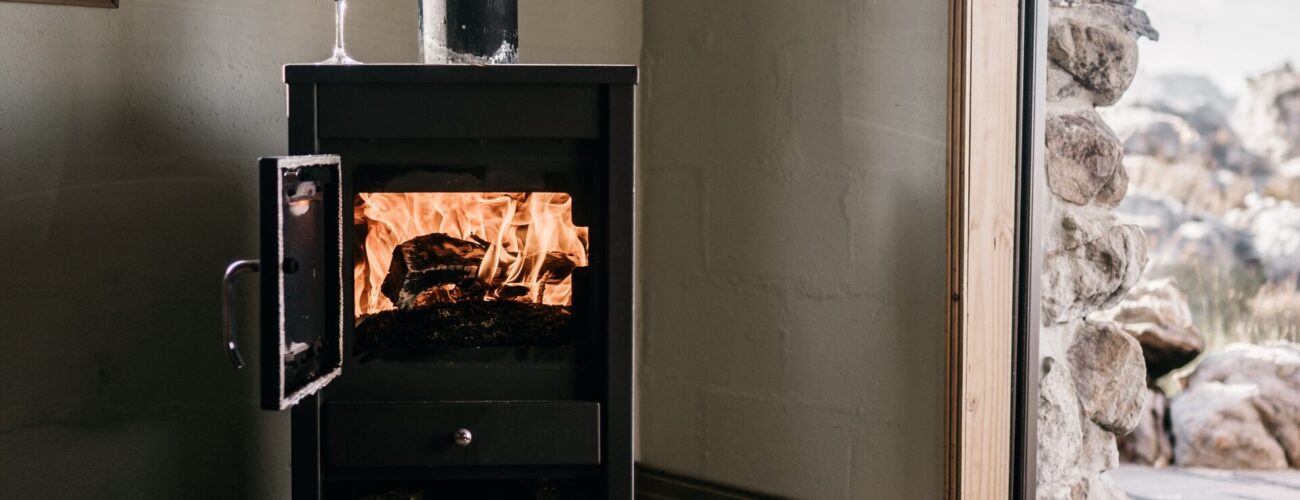

A Hot Topic – How to Move a Wood Stove
Posted in How-to,Moving Tips & Tricks on March 21, 2023
If you’re a homeowner who relies on a wood stove for warmth and comfort during the colder months, you may find yourself facing the daunting task of moving it. Whether you’re relocating to a new home or simply rearranging, knowing how to move a wood stove is crucial to ensure safe relocation.
To start preparing a wooden stove correctly, make sure you have all the necessary tools and equipment, such as a dolly, moving straps, and gloves. Next, disconnect the stove from the chimney and remove any accessories, such as the stovepipe and firebricks. Use the dolly to carefully move the stove to its new location, ensuring that it is secure and stable at all times. Finally, reattach the stovepipe and chimney and make any necessary adjustments to ensure proper ventilation. Always use caution when carrying heavy items, and consider enlisting the help of professional long-distance movers.
How to Move a Wood Stove – Start Preparing on Time
If you’re planning to pack your wood stove and prepare it for moving across the country, it’s important to start preparing on time. A wood stove is heavy and cumbersome (not like a piano, but nonetheless) and also requires careful planning and preparation to ensure a safe and successful relocation. Waiting until the last minute can lead to unnecessary stress and potential damage to the stove. So, start preparing early, gather all the necessary tools and equipment, and consider enlisting the help of professionals to ensure a smooth and stress-free relocation.
Gather the Necessary Tools and Equipment
To ensure a successful and safe relocation of your wood stove, you’ll need to have the right tools and equipment on hand. Having the necessary tools can make the job much easier and help prevent injury or damage to the stove. Here are some of the tools and relocation essentials you’ll need for packing a wood stove:
- A wood stove dolly,
- Moving straps,
- Gloves,
- Screwdrivers,
- Wrenches,
- Allen keys,
- Tarp or plastic sheeting,
- Cleaning supplies.
Clear the Path For Cross-Country Movers
If you’ve decided to invest in cross-country moving services, you should prepare your house for movers. Take the time to clear any obstacles that may impede the path of the long-distance movers, such as furniture, rugs, or other household items. Make sure the path is clear of debris, and remove any tripping hazards. This will not only help prevent injury but also make the relocation quicker and more efficient.
Protect the Floors and Walls From Damage
When moving a wood stove, it’s important to protect your floors and walls from damage. The stove is heavy and can scratch or scuff flooring and walls if not moved properly. There are several relocation hacks that can help, and one of them is that you can even use some cheap supplies for this (you can find some on Freecycle, for instance). Start by using a tarp or plastic sheeting to cover the path where the stove will be moved. You can also use different packing materials, such as cardboard, to create a protective layer between the stove and the floor. For the walls, use blankets or specialized pads to cover them and prevent any accidental scratches or scuffs.
Disconnect the Stove
Disconnecting the stove from any electrical or plumbing connections is as important as disconnecting it from the chimney pipe. Start by shutting down the stove and letting it cool down. Next, turn off the power supply and disconnect any electrical connections, such as a blower or thermostat. If the stove is connected to a water supply, turn off the valve and disconnect the plumbing connections. Finally, disconnect the chimney pipe and stove pipe, and remove any additional accessories, such as firebricks or ash pans.

Moving the Stove – Should You Leave it to Professionals?
Moving a wood stove is a challenging and potentially dangerous task, especially when it involves relocating the stove across the country. So, how to move a stove by yourself? While it’s possible to handle it yourself with the right tools and equipment, and a good packing strategy, it may be safer and more efficient to hire cross-country movers to do it.
Use Cross Country Movers to Handle All of Your Heavy Items
Experienced cross-country movers usually offer packing services, and they have the skills, knowledge, and equipment needed to handle all of your heavy items, including a wood stove. They can ensure that the stove is properly disconnected, packed, and transported to your new home while minimizing the risk of damage or injury. So, if you want to ensure a safe and stress-free relocation, consider choosing a cross-country moving company to handle all of your heavy items, including your wood stove.

How to Reconnect the Stove Once It is Moved Into Your New Home
Once you have moved to a new state and settled your wood stove into a new home, it’s important to properly reconnect it to ensure that it functions safely and efficiently. There are several steps you should follow to make sure you’ve unpacked correctly and that everything is in place.
Position the Stove in Its New Location
Choose a safe and suitable location for the stove that is away from any flammable materials or hazards. Make sure that the floor can handle the weight of the stove and that it is level. Make sure that the stove is positioned correctly and securely in the designated area.
Reconnect the Chimney Pipe and the Stove Pipe
The chimney pipe is an essential part of your stove’s ventilation system, and it helps to remove smoke and other harmful gases from your home. To reconnect the chimney pipe, first ensure that the pipe is clean and free of debris. Then, connect the stove pipe to the stove’s flue collar and secure it in place using screws or clamps. Finally, attach the other end of the chimney pipe to the wall or ceiling using appropriate brackets and hardware. Make sure that the chimney pipe is properly aligned and sealed to prevent any leaks.
Reconnect Any Electrical or Plumbing Connections
If your stove has any electrical or plumbing connections, such as a power cord, gas line, or water line, make sure that they are properly connected and secured. If you are unsure how to reconnect these connections, consult a professional to avoid any safety hazards. For electrical connections, ensure that the wires are connected correctly and secured with wire nuts or other appropriate connectors. For plumbing connections, make sure that the pipes are properly aligned and tightened to prevent leaks.
Don’t Forget to Test the Stove
Here are some additional tips for an interstate relocation with such a heavy item. After you have reconnected your stove’s chimney pipe, stove pipe, and any electrical or plumbing connections, it’s important to test the stove to ensure that everything is working properly. Turn on the stove and observe the flames or heat to make sure it is heating up properly. Check for any leaks, unusual smells, or other signs of malfunction. If you notice any problems, turn off the stove immediately and seek professional assistance to resolve the issue.
Inspect the Stove for Damage
Before reconnecting your stove, it’s important to thoroughly inspect it for any signs of damage. Look for cracks, dents, or other visible damage that may affect the stove’s performance or safety. If you notice any damage, address it before attempting to reconnect the stove.
Clean the Stove and Chimney
Once you’re confident that the stove is in good condition, take the time to clean both the stove and chimney. Clear any debris or blockages from the chimney and stove pipe, and use a soft cloth or brush to clean the stove’s exterior.
Make Any Necessary Adjustments
Turn it on and observe the flames or heat to ensure that it’s heating up correctly. If you notice any issues, make any necessary adjustments, or consult a professional to resolve any problems. By following these steps, you can ensure that your stove is properly reconnected and working safely in your new home.
If you need some additional tips on how to get more heat from your stove, watch the following video.
With the Right Help, Moving a Stove Won’t Be a Problem
Relocating a stove can be a challenging task, especially if you’re not familiar with the process. However, with the right help and with some packing tips, it can be much easier and less stressful. There are professional long-distance moving companies that specialize in packing heavy appliances, including stoves. These companies have the equipment, tools, and expertise to safely and efficiently handle your stove, without damaging it or injuring anyone in the process.
Cross Country Movers is a professional relocation company that specializes in moving across the country, including the relocation of heavy appliances like stoves. We have the necessary tools and expertise to safely pack, load, transport, and unload your stove, regardless of its size or weight.
FAQ
Why would I need to move a wood stove?
You may need to handle a wood stove for reasons such as home renovations, safety concerns, improved heating efficiency, or aesthetic purposes. You might also need some instructions on how to handle it if you’re moving cross-country and you want to do it in a safe manner.
Can I move a wood stove by myself or do I need help?
Moving a wood stove can be a difficult and potentially dangerous task, so it’s generally recommended that you seek assistance from a professional or have someone help you. It’s important to ensure that the stove is properly disconnected, lifted, and moved without causing any damage to yourself or your home.
How do I choose a new location for the wood stove?
When choosing a new location for a wood stove, consider factors such as ventilation, proximity to combustible materials, and heating efficiency. The stove should be placed in an area with proper ventilation to prevent the buildup of harmful gases, and it should be located at a safe distance from walls, furniture, and other flammable materials. Additionally, choosing a central location in your home can help to improve the stove’s heating efficiency and distribute heat evenly throughout the space.
What tools and equipment do I need to move a wood stove?
To handle a wood stove, you will typically need a few tools and pieces of equipment, including heavy-duty work gloves, a dolly or hand truck, furniture blankets, straps or ropes, and possibly a floor protector to prevent damage to your flooring. Additionally, you may need a wrench or other tools to disconnect the stove from any gas, electrical or venting connections.
How do I disconnect the chimney pipe?
To disconnect the chimney pipe from a wood stove, first, ensure that the stove is completely cooled down. Then, locate the connection point where the pipe attaches to the stove and use a wrench or other appropriate tool to loosen and remove any bolts or screws securing the pipe. Next, carefully pull the pipe away from the stove, being mindful of any screws, brackets, or other connectors that may need to be detached. Finally, cover the opening of the pipe to prevent debris or animals from entering the chimney.
How do I protect my floors and walls from damage when moving the wood stove?
To protect your floors and walls when handling a wood stove, you can use blankets, cardboard, or other protective coverings to create a barrier between the stove and your surfaces. Additionally, you may want to use a floor protector or drop cloth to prevent any scratches or dings from occurring during the relocation.
Can I move a wood stove over the carpet or other soft flooring?
Handling a wood stove over the carpet or other soft flooring can be challenging, as the weight of the stove may cause it to sink into the carpet fibers or cause damage to the flooring. It’s generally recommended to move a wood stove over a hard surface, such as tile, concrete, or hardwood flooring. If you must do it, consider using plywood or heavy-duty cardboard to create a smooth surface that can support the weight of the stove and prevent damage to the carpet fibers.
How do I clean the wood stove before moving it?
To clean a wood stove properly, first, ensure that the stove is completely cooled down and remove any ash or debris from the firebox using a fireplace shovel or other appropriate tool. Next, use a wire brush or scraper to remove any built-up creosote or other residues from the interior walls of the stove, being careful not to scratch the metal. Finally, wipe down the exterior of the stove with a damp cloth to remove any dirt or soot, and dry thoroughly.
How do I secure the wood stove for transport?
To secure a wood stove for transport, first, ensure that it’s completely cooled down and disconnected from any gas, electrical or venting connections. Next, use straps or ropes to secure the stove to a sturdy dolly or hand truck, ensuring that the straps are tight and the stove is stable. Additionally, use blankets or other padding to protect the stove from scratches or dings during transport. If you’re transporting the stove in a vehicle, be sure to use proper tie-downs or other securing mechanisms to prevent the stove from shifting or tipping during transit.
Do I need to take any special precautions when moving a cast iron wood stove?
Cast iron stoves are heavy and brittle, so it’s important to use proper lifting techniques, secure the stove carefully for transport, and avoid dropping or banging it against hard surfaces.
How do I reconnect the chimney pipe?
To reconnect the chimney pipe, simply slide it back into place on the stove’s exhaust outlet and use bolts or screws to secure the pipe in place.
How do I test the wood stove after moving it?
To test the wood stove after reconnecting it, start a small fire and monitor the stove closely for any signs of smoke, gas leaks, or other issues. Ensure that the stove is operating safely and efficiently and that it’s heating your home evenly and effectively. If you notice any problems or issues, address them promptly to prevent further damage or safety concerns.
Do I need to have my wood stove inspected after moving it?
It’s generally recommended to have a wood stove inspected by a professional after it’s been moved to ensure that it’s properly installed and functioning safely. An inspection can help to identify any potential safety hazards or issues and ensure that the stove is in compliance with local building codes and regulations.
How long does it take to move a wood stove?
The time it takes to handle a wood stove can vary depending on the size of the stove, the distance it needs to be moved, and the complexity of the installation.
What are some common mistakes to avoid when moving a wood stove?
Some common mistakes to avoid when handling a wood stove include failing to properly disconnect the stove from gas, electrical, or venting connections, attempting to handle the stove alone, not using proper lifting techniques, not protecting floors and walls from damage, not securing the stove properly for transport, and failing to follow safety precautions and manufacturer guidelines.
Can I reuse the same chimney pipe after moving the wood stove?
In most cases, you can reuse the same chimney pipe after moving a wood stove, as long as it’s still in good condition and the proper length and size for the new location. However, it’s important to inspect the chimney pipe for any signs of damage, wear, or corrosion and replace it if necessary.
What should I do if I encounter any problems when moving the wood stove?
If you encounter any problems with a wood stove during a relocation, such as having difficulty disconnecting or reconnecting it, issues with securing the stove for transport, or concerns about the stove’s safety or functionality, seek assistance from a professional.
Can I store the wood stove outside temporarily before moving it?
You can store a wood stove outside temporarily, as long as it’s properly protected from the elements and potential damage. Cover the stove with a tarp or other waterproof cover to prevent exposure to moisture or other environmental factors that could cause damage or rust.
Can I move a wood stove to a different room in the same house?
Yes, you can move a wood stove to a different room in the same house, but it should be done by a professional to ensure proper installation and safety.
Do I need to have any special permits or inspections to move a wood stove?
The requirements for permits and inspections vary depending on your location and local building codes. It’s best to check with your local government or building department to determine if any permits or inspections are required for moving a wood stove in your area.







